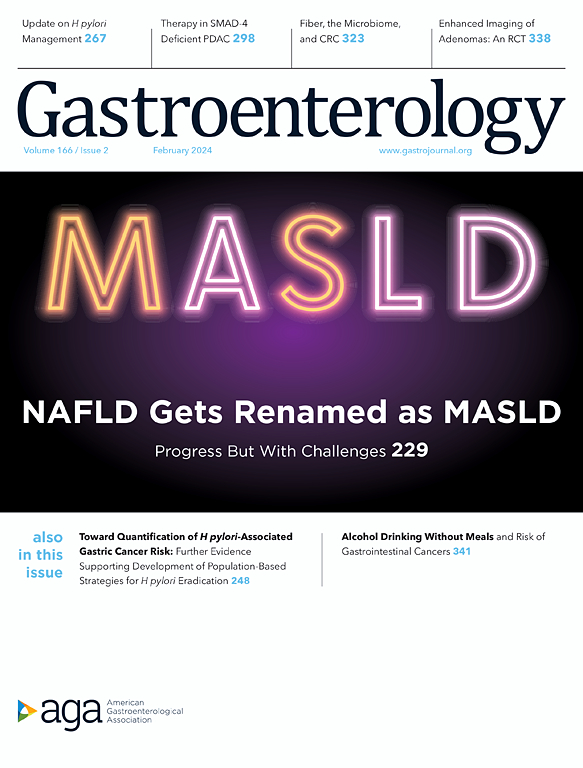Continuing the Commitment to Diversity, Equity, and Inclusion Within AGA Journals
IF 25.7
1区 医学
Q1 GASTROENTEROLOGY & HEPATOLOGY
引用次数: 0
Abstract
Section snippets
Over 2 Years Covering a Broad Range of DEI Topics
In our time as DEI section editors, we published 27 manuscripts in the DEI sections for Gastroenterology and CGH between July 2022 and September 2024. Most pieces (23) were copublished in the two journals, with 1 additional manuscript published solely in Gastroenterology and 3 published solely in CGH.As intended, the range of topics covered has been broad, encompassing subjects in both gastroenterology and hepatology. While most pieces are commentaries, the DEI section has also housedViews, Downloads, and Citations
Between July 2022 and September 2024, the 27 published DEI section manuscripts were viewed or downloaded a total of 68,150 times combined for Gastroenterology and CGH (mean 1434 [range 231–3242]). Views and downloads per article ranged from 303 to 3242 for Gastroenterology (compared with 71 to 19,586 for non-DEI articles) and from 231 to 1577 for CGH (compared with 18 to 4928 for non-DEI articles). Articles in the DEI section were cited an average of 2.1 times (both journals combined) with aSocial Media Engagement
As section editors, we use social media to promote each accepted manuscript at the time of online publication. On the platform X (formerly known as Twitter), the average engagement rate for DEI posts from October 2022 to September 2024 was 1.97% (Hootsuite/X; data were current as of September 10, 2024). For context, Adobe’s 2022 guide to social media rates explains that, while goals might vary depending on the platform and size of the business, an engagement rate greater than 1% on X isDEI Within the AGA Journal Boards of Editors and Editorial Boards
The AGA journals routinely monitor metrics for efforts related to DEI, including the diversity of each journal’s board of editors (BOE) and editorial board (EB). All data are self-reported by individuals in their AGA member profile and maintained in the AGA member database. Of note, data for sex, race, and ethnicity are not reported by many individuals, and geographic location is manually assigned based on the individual’s institution when missing.The BOE refers to the group of editors, led byAuthor Survey Results
In addition to promoting content focused on GI health equity and equity in the GI workforce, another goal of the section was to amplify work created by underrepresented authors with expertise in these areas. Authors comprise a prestigious and broad cohort, including physicians and scientists in gastroenterology and hepatology subspecializing in colorectal cancer, liver disease, and inflammatory bowel disease among other areas, with overlapping foci on health disparities. We sought to learn fromConcluding Thoughts
We are honored to contribute to the AGA by serving as DEI section editors for the past 2.5 years, and by the trust bestowed upon us to curate material with the goal to help educate AGA journal readership about underserved populations and persistent disparities in our field. As we approach the second half of our terms, we are encouraged by high readership engagement and positive author experience. We envision ongoing growth and evolution of the section in its purpose, content, and authorship. WeAcknowledgments
The authors acknowledge Gina Reitenauer and Nick Tomeo for their assistance with data acquisition and interpretation.Author Contributions
Sandra M. Quezada: conceptualization, data collection and interpretation, drafting, editing. Folasade P. May: conceptualization, data collection and interpretation, drafting, editing.继续致力于AGA期刊的多样性、公平性和包容性
在我们作为DEI章节编辑的时间里,我们在2022年7月至2024年9月期间在胃肠病学和CGH的DEI章节发表了27篇手稿。大部分论文(23篇)在两种期刊上共同发表,另有1篇论文在胃肠病学杂志上单独发表,3篇论文在CGH杂志上单独发表。正如预期的那样,所涵盖的主题范围很广,包括胃肠病学和肝病学的主题。虽然大多数文章是评论,但DEI部分也有浏览、下载和引用。在2022年7月至2024年9月期间,胃肠病学和CGH的27篇发表的DEI部分手稿共被浏览或下载68,150次(平均1434次[范围231-3242])。胃肠病学的每篇文章的阅读量和下载量从303到3242不等(非dei文章为71到19586),CGH的每篇文章的阅读量和下载量从231到1577不等(非dei文章为18到4928)。DEI部分的文章平均被引用2.1次(两种期刊加起来)。作为部分编辑,我们在在线出版时使用社交媒体来推广每篇被接受的手稿。在X平台(以前称为Twitter)上,从2022年10月到2024年9月,DEI帖子的平均参与率为1.97% (Hootsuite/X;数据截止到2024年9月10日)。作为背景,Adobe的2022年社交媒体率指南解释说,虽然目标可能因平台和业务规模而异,但在AGA期刊编辑委员会和编辑委员会内部,X isDEI的参与率超过1% AGA期刊定期监测与DEI相关的指标,包括每个期刊的编辑委员会(BOE)和编辑委员会(EB)的多样性。所有数据均由个人在其AGA成员档案中自我报告,并保存在AGA成员数据库中。值得注意的是,许多个人没有报告性别、种族和民族的数据,地理位置是根据个人所在机构手动分配的。BOE指的是由作者调查结果领导的编辑小组。除了促进以GI健康公平和GI劳动力公平为重点的内容外,该部分的另一个目标是扩大代表性不足的具有这些领域专业知识的作者的作品。作者包括一个享有盛誉和广泛的队列,包括胃肠病学和肝病学的医生和科学家,专门研究结直肠癌、肝脏疾病和炎症性肠病等领域,重点关注健康差距。我们很荣幸能够在过去的两年半里担任美国农业协会(AGA)的DEI部分编辑,并对我们的信任做出贡献,我们的目标是帮助AGA杂志的读者了解服务不足的人群和我们领域中持续存在的差异。当我们接近后半期时,我们受到了高读者参与度和积极的作者体验的鼓舞。我们设想该部分在其目的、内容和作者身份方面的持续增长和演变。作者感谢Gina Reitenauer和Nick Tomeo在数据采集和解释方面提供的帮助。sandra M. Quezada:概念化,数据收集和解释,起草,编辑。Folasade P. May:概念化,数据收集和解释,起草,编辑。
本文章由计算机程序翻译,如有差异,请以英文原文为准。
求助全文
约1分钟内获得全文
求助全文
来源期刊

Gastroenterology
医学-胃肠肝病学
CiteScore
45.60
自引率
2.40%
发文量
4366
审稿时长
26 days
期刊介绍:
Gastroenterology is the most prominent journal in the field of gastrointestinal disease. It is the flagship journal of the American Gastroenterological Association and delivers authoritative coverage of clinical, translational, and basic studies of all aspects of the digestive system, including the liver and pancreas, as well as nutrition.
Some regular features of Gastroenterology include original research studies by leading authorities, comprehensive reviews and perspectives on important topics in adult and pediatric gastroenterology and hepatology. The journal also includes features such as editorials, correspondence, and commentaries, as well as special sections like "Mentoring, Education and Training Corner," "Diversity, Equity and Inclusion in GI," "Gastro Digest," "Gastro Curbside Consult," and "Gastro Grand Rounds."
Gastroenterology also provides digital media materials such as videos and "GI Rapid Reel" animations. It is abstracted and indexed in various databases including Scopus, Biological Abstracts, Current Contents, Embase, Nutrition Abstracts, Chemical Abstracts, Current Awareness in Biological Sciences, PubMed/Medline, and the Science Citation Index.
 求助内容:
求助内容: 应助结果提醒方式:
应助结果提醒方式:


